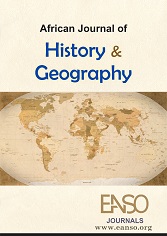Archaeometallurgical Characterisation of Iron Production at Mukongoro Rock Art Site in Eastern Uganda
Abstract
This paper reconstructs the nature of iron production technology through the morphological analysis of slag and tuyere remains at the Mukongoro rock art site in Eastern Uganda. The specific objectives included: characterising the technological features of iron production depicted from slag and tuyere remains, reconstructing the iron production process by interpreting attributes such as slag and tuyere morphology, colour and magnetism, and enhancing understanding of iron production traditions in eastern Uganda to position Mukongoro rock art sites and Uganda within regional and global archaeometallurgical debates. Through archaeological surveys and excavations, 2,861 slag and 199 tuyere remains were identified. The attributes analysed included thermal conditions, morphology, surface condition, magnetism, weathering, colour, porosity, and inclusions. Morphological analysis indicates that the slag is predominantly flow slag, characterised by a dome-shaped morphology. The slag exhibited medium magnetism, a dark brown colour, low porosity, and most inclusions were infused in a very rough surface, implying the use of low temperatures, skill, and a deliberate choice by the people at the time. While the tuyeres were 35mm in diameter, they showed no evidence of slag coating or clogging, and some were primarily composed of completely vitrified body parts, suggesting the use of small furnaces. Therefore, iron production technology at Mukongoro is characterised by a non-tapping bloomery, as evidenced by its dome shape. The rough surface and black and grey colours reflect the skill of the smelters, who likely used low temperatures and insufficient airflow. The inclusions of reeds, grass and a leaf indicated the use of plants at the various stages of iron production..
Downloads
References
Ashley, C. Z. (2010). Towards a socialised archaeology of ceramics in Great the Lakes Africa. African Archaeological Review, 27, 135–163.
Ayebare, E. (2024). Characterising the archaeological assemblage at the Mukongoro Rock Art Site in Eastern Uganda (Doctoral dissertation, Makerere University).
Baker, S. (1867). The Albert N’yanza, great Basin of the Nile and explorations of the Nile sources. Macmillan and Company, Limited.
Benvenuti, M., Carnicelli, S., Lofrumento, C., Pecchioni, E., Ricci, M., & Vaselli, O. (2013). A Vanishing Heritage of Lake Victoria Region: Contents of Paleoenvironmental and Archeometric Investigations. In Uganda Rock Art sites (pp. 61–71). National Museum of Uganda.
Besigye, J. N., Musalizi, S., & Asiimwe, R. (2023). Challenges in Preparing a Serial Transnational Nomination for Geometric Rock Art Sites in the Lake Victoria Region of Kenya, Tanzania, and Uganda. In Managing Transnational UNESCO World Heritage Sites in Africa (pp. 11–23). Cham: Springer International Publishing.
Blakelock, E., Martinón-Torres, M., Veldhuijzen, H. A., & Young, T. (2009). Slag inclusions in iron objects and the quest for provenance: an experiment and a case study. Journal of Archaeological Science, 36(8), 1745-1757.
Buchwald, V. F., & Wivel, H. (1998). Slag analysis as a method for the characterisation and provenancing of ancient iron objects. Materials characterisation, 40(2), 73–96.
Chaplin, J. H., & McFarlane, M. J. (1967). The Moniko Petroglyphs. Uganda Journal, 33, 207–208.
Childs, S. T. (1991). Style, technology, and iron smelting furnaces in Bantu-speaking Africa. Journal of Anthropological Archaeology, 10(4), 332–359.
Childs, S. T. (1998). Find the ekijunjumira iron mine discovery, ownership and power among the Toro of Uganda. In A.B. Knapp, V.C. Piggott and E.W. Herbert, editors, Social Approaches to an Industrial Past: the archaeology and anthropology of mining, pp. 110–116. Routledge, London.
Childs, S. T. (2002). ‘Find the ekijunjumira’: iron mine discovery, ownership and power among the Toro of Uganda. In Social Approaches to an Industrial Past (pp. 139-153). Routledge.
Childs, S. T. (2008). Metallurgy in Africa. In Encyclopaedia of the History of Science, Technology, and Medicine in Non-Western Cultures (pp. 1596-1601). Springer, Dordrecht.
Childs, S.T. & D. Killick. (1993). Indigenous African metallurgy: nature and culture. Annual Review of Anthropology 22:317-37.
Chirikure, S. (2005). Iron production in Iron Age Zimbabwe: stagnation or innovation? University of London, University College London (United Kingdom).
Chirikure, S., & Rehren, T. (2004). Ores, furnaces, slags, and prehistoric societies: aspects of iron working in the Nyanga Agricultural Complex, AD 1300–1900. African Archaeological Review, 21(3), 135–152.
Coulson, D., & Campbell, A. (2010). The dawn of imagination: rock art in Africa. Trust for Africa Rock Art, Kenya
Crew, P. (1991). The experimental production of prehistoric bar iron. Hist. Metall., 25(1), 21-36.
Grant, J. (1864). A Walk across Africa: Or domestic scenes from my Nile journal, London: William Blackwood and Sons.
Humphris J., M. Martinon-Torres, T. Rehren & A. Reid (2009). Variability in single smelting episodes – a pilot study using iron slag from Uganda. Journal of Archaeological Science 36(2): 359–369.
Humphris, J. (2002). An Ethno-Historic Investigation of Iron Smelting in the Buganda Kingdom (Doctoral dissertation, University of Manchester).
Humphris, J. E. (2010). An archaeometallurgical investigation of iron smelting traditions in southern Rwanda (Doctoral dissertation, UCL (University College London).
Humphris, J., & Iles, L. (2013). Pre-colonial iron production in Great Lakes Africa: Recent research at UCL Institute of Archaeology. The world of iron, 56–65.
Humphris, J., & Rehren, T. (2014). Iron production and the Kingdom of Kush: An introduction to UCL Qatar’s research in Sudan. Ein Forscherleben zwischen den Welten, 177–190.
Humphris, J., Martinon-Torres, M., Rehren, T., & Reid, A. (2009). Variability in single smelting episodes – a pilot study using iron slag from Uganda. Journal of Archaeological Science, 36(2), 359–369.
Iles, L. (2012). Reconstructing the Iron Production Technologies of Western Uganda: reconciling archaeometallurgical and ethnoarchaeological approaches. Azania: Archaeological Research in Africa, 47(2), 244-245.
Iles, L. (2016). Iron production in Uganda: memories of a near-forgotten industry. In Reanimating Industrial Spaces (pp. 158-175). Routledge.
Iles, L. E. (2017). African Iron Production and Iron-Working Technologies: Methods. In Oxford Research Encyclopedias, African History. https://doi.org/10.1093/acrefore/9780190277734.013.212
Iles, L.E. & Martinon-Torres, M. (2009). Pastoralist iron production on the Laikipia Plateau, Kenya: wider implications for archaeometallurgical studies. Journal of Archaeological Science, 36(10), 2314–2326.
Iles, L.E. (2009). Impressions of banana pseudostem in iron slag from eastern Africa. Ethnobotany Research and Applications 7: 283-91.
Iles, L.E. (2013). “The Development of Iron Technology in Pre-Colonial Western Uganda”, Azania: Archaeological Research in Africa, 43(1): 65-90.
Iles, L.E. (2014). Iron Production in Uganda: memories of a near-forgotten industry. In: Orange, H., (ed.) Reanimating Industrial Spaces: Conducting Memory Work in Post-Industrial Societies. Left Coast Press / Routledge, Walnut Creek, pp. 158–175.
Iles, L.E. (2019). Exploring the impact of iron production on forest and woodland resources: estimating fuel consumption from slag. Star: science & technology of archaeological research, 5(2), 179-199.
Iles, L.E., Robertshaw, P., & Young, R. (2014). A furnace and associated iron-working remains at Munsa, Uganda. Azania: Archaeological Research in Africa, 49(1), 45–63.
Kinyera Okeny, C., Kyazike, E., & Gumoshabe, G. (2020). Critical analysis of archaeological research trends in Uganda: 1920-2018.
Kyazike, E. & A. G. Mehari (2024). The Archaeological Research Agenda in Uganda, 1922-Present. Mawazo, the Journal of the College of Humanities and Social Sciences, Makerere University, Volume 16 (1), 76–100.
Kyazike, E. (2013). Archaeological examination of cultural interactions in the upper Nile catchment areas: 6000 to 1500 before present. PhD Thesis, University of Dar es Salaam. Dar es Salaam: E&D Vision Publishing
Kyazike, E. (2022). Later Stone and Iron Age Cohabitation at the Nsongezi Open-Air Site, Western Uganda. Africa Review, 14(1), 1-23.
Kyazike, E., R. Ssemulende, E. Ayebare, C.K. Okeny, T. Namuddu & F. Mirembe (2025). Understanding Later Stone Age Behaviour through Lithic Techno-Typology at Mukongoro and Kapir Rock Art Sites. West African Journal of Archaeology, Volume 54. Forthcoming.
Lawrence, J.C.D. (1953). Rock Paintings in Teso. Uganda Journal. Volume 17 (1), 8–13.
Lyaya, E. C. (2019). An identification guide for metallurgical sites in Tanzania. African Archaeological Review, 36(2), 193–209.
Malikasri, N. B. R., Kishore, K., Arora, K. S., & Mahobia, G. S. (2025). Failure mechanisms of blast furnace tuyeres and mitigation strategies: A comprehensive review. Engineering Failure Analysis, 167, 108968.
Mapunda, B. B. (1995). An archaeological view of the history and variation of iron-working in south-western Tanzania. University of Florida PhD Thesis.
Mirembe, F. (2024). Archaeometallurgical investigation of iron production technology in Butiru, Eastern Uganda (Doctoral dissertation, Makerere University).
Nakaweesa, E. (2011). Cultural transition from the Later Stone Age to Iron Age cultures: A case study of the Nyero rock shelter, Kumi District, Eastern Uganda (Master’s Dissertation, University of Dar es Salaam).
Namono, C. (2008). Rock art, myth and sacred landscapes: the case of a rock art site in Tororo District, Uganda. Southern African Humanities, 20(2), 317–331.
Namono, C. (2010). Surrogate Surfaces: A Contextual Interpretive Approach to the Rock Art of Uganda. (Doctoral dissertation, University of the Witwatersrand).
Nelson, C. M., & Posnansky, M. (1970). The stone tools from the re-excavation of Nsongezi Rock Shelter, Uganda. Azania: Journal of the British Institute in Eastern Africa, 5(1), 119–172.
Nyiracyiza, J. & E. Kyazike. (2022). The Archaeology of Kakoro and Komuge Rock Art Sites in Eastern Uganda. Studies in the African Past, 16(1).78-119.
Nyiracyiza, J. (2013). Investigating Iron-working in Kigezi Highlands, South-western Uganda, University of Dar es Salaam, (Unpublished M.A. Dissertation).
Nyiracyiza, J., & Turchetta, B. (Eds.). (2013). Uganda Rock Art Sites: A Vanishing Heritage of Lake Victoria Region. National Museum of Uganda.
Pearce, S., & Posnansky, M. (1963). The re-excavation of Nsongezi rock-shelter, Ankole. Uganda Journal, 27(1), 85–94.
Perryman, P. W. (1937). ‘Native witchcraft’, Uganda Journal 4 (1), 7–27.
Posnansky, M. (1961). Pottery types from archaeological sites in East Africa. The Journal of African History, 2(2), 177-198.
Posnansky, M., & Nelson, C. M. (1968). Rock paintings and excavations at Nyero, Uganda. Azania: Journal of the British Institute in Eastern Africa, 3(1), 147–166.
Purvis, J. B. (1909). Through Uganda to Mount Elgon. T. Fisher Unwin.
Reid, A. (2002). Recent archaeological discoveries in Buganda and their implications for heritage management policies. Uganda Journal, 48, 87–102.
Reid, A., & MacLean, R. (1995). Symbolism and the social contexts of iron production in Karagwe. World Archaeology, 27(1), 144–161.
Reid, A., & Young, R. (2003). Iron-smelting and bananas in Buganda. Oxford University School of Archaeology Monograph, 57, 118–123.
Robertshaw, P. (1994). Archaeological Survey, Ceramic Analysis, and State Formation in Western Uganda. African Archaeological Review, 12(1), 105–131.
Robertshaw, P. (1997). Munsa earthworks: a preliminary report on recent excavations. Azania: Journal of the British Institute in Eastern Africa, 32(1), 1–20.
Roscoe, J (1911). The Baganda: An Account of their Customs and Beliefs, Macmillan and Co, Ltd, London.
Roscoe, J. (1924). The Bagesu and other tribes of the Uganda protectorate: The third part of the report of the Mackie ethnological expedition to Central Africa. The University Press. Cambridge.
Schmidt, P. R. (1975). A new look at interpretations of the Early Iron Age in East Africa. History in Africa, 2, 127–136.
Schmidt, P. R. (1997). Iron Technology in East Africa: Symbolism, Science and Archaeology, Indiana University Press, Indianapolis, USA.
Schmidt, P. R., & Avery, D. H. (1983). More evidence for an advanced prehistoric iron technology in Africa. Journal of Field Archaeology, 10(4), 421–434.
Soper, R. (1971). A general review of the Early Iron Age of the southern half of Africa. Azania: Journal of the British Institute in Eastern Africa, 6(1), 5–37.
Sutton, J. E. (1993). Further excavations and the Iron Age sequence of the Central Rift. AZANIA: Journal of the British Institute in Eastern Africa, 28(1), 103–125.
Sutton, J. E. (1998). Ntusi and Bigo: farmers, cattle-herders and rulers in western Uganda, AD 1000-1500. Azania: Archaeological Research in Africa, 33, 39–72.
Tylecote, R. F. (1987). The early history of metallurgy in Europe. Longman.
Wamutu, G. (2010). The Archaeometallurgical Investigation of Eastern Uganda: A Case Study of Sere Village, Tororo District. University of Dar es Salaam, (Unpublished M.A. Dissertation).
Copyright (c) 2025 Elizabeth Kyazike, Fatumah Mirembe, Ssemulende Robert, Nyiracyiza Jackline Besigye, Ayebare Eugene, Okeny Charles Kinyera, Namuddu Teddie

This work is licensed under a Creative Commons Attribution 4.0 International License.




























